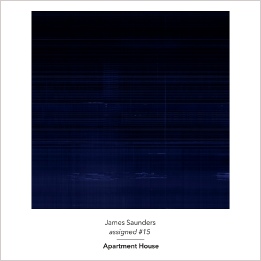 James Saunders spent close to a decade working on his #[unassigned] series. Comprising 175 variations of modular compositions for solo instruments, the project was designed to emphasize unique instrumentation, techniques, and spaces. Repetition was anathema and multiplicity prized—once performed, each arrangement would then be set aside in favor of the next configuration, never to be played again. The UK-based multinational ensemble Apartment House were the first to try an #[unassigned] composition in 2000 and they executed several different versions afterward, until the project was concluded in 2009. With assigned #15, they return to Saunders’s work, now presented as re-performable composition scored for seven musicians who play, among other things, viola, chamber organ, dictaphone, and shortwave radio.
James Saunders spent close to a decade working on his #[unassigned] series. Comprising 175 variations of modular compositions for solo instruments, the project was designed to emphasize unique instrumentation, techniques, and spaces. Repetition was anathema and multiplicity prized—once performed, each arrangement would then be set aside in favor of the next configuration, never to be played again. The UK-based multinational ensemble Apartment House were the first to try an #[unassigned] composition in 2000 and they executed several different versions afterward, until the project was concluded in 2009. With assigned #15, they return to Saunders’s work, now presented as re-performable composition scored for seven musicians who play, among other things, viola, chamber organ, dictaphone, and shortwave radio.
There’s a trace of contradiction in the idea of a once-performed composition. Composing usually entails repetition, regardless of whether variables are introduced to the score. It’s an activity that, either accidentally or purposefully, preserves a number of materials and actions for future use. Even something like John Cage’s Variations II, which requires its interpreter to arrange and measure a series of 11 transparent sheets in almost any way at all, can be repeated, in the sense that different configurations can be saved and attempted again after the first go.
Saunders went a step further with his #[unassigned] works and filed each one away after just a single rendition. What survived between the reshufflings were the constituent parts, the instructions that guided the flute player to sustain a series of long low tones in succession, or that asked the cellist to rub his or her strings without producing a pitch. The series both privileged and minimized the roles of time and structure in music. In one way, #[unassigned] persisted as an asterism of instructions, in another it survived because those instructions were intermittently organized so that a group could recognize and perform them in relationship to one another.
With assigned #15, Saunders exhumed an old #[unassigned] variant and recorded it with Apartment House at St. Paul’s Hall in the West Yorkshire town of Huddersfield. In an interview on the Another Timbre website, James says that he returned to this material because he wanted "explore the beauty of sound again," versus focusing on the processes that produce such sound. assigned #15, then, is music frozen into a particular shape.
It’s a decent image for what the album sounds like: a dense, opaque block of ice shaking under internal pressures. A constant machine-like drone rumbles throughout the piece, its source not easy to determine. It could come from the chamber organ, but it might be the product of the dictaphones and shortwave radio too. Similarly, some of the tapping, rhythmic sounds could be traced back to string instruments or they could as easily belong to the percussion section.
Bowed metal, quickly struck piano keys, scratch tones, rattling chains, and piercing train-whistle whines also find a place in the music. They move in and around each other with such ease that it’s hard to find where one section ends and the next begins, and that contributes to the performance’s heaviness. All of the softer sounds, like the fragile string and flute interaction in the album’s second half, congeal with the rougher-edged, glass-on-sandpaper textures, forming a tight grid of noise that never loosens, even as the work winds down and the chamber organ hums in relative isolation. The piece changes over time, but it never seems to move forward. Instead, it spins in place, or spins and simultaneously revolves. Different facets reflect off its surface as it moves through different positions, but its insides are always hidden. The music may be frozen in its course now, but the sound travels forward anyway, with or without the composer’s dispensation.
samples:
Read More

